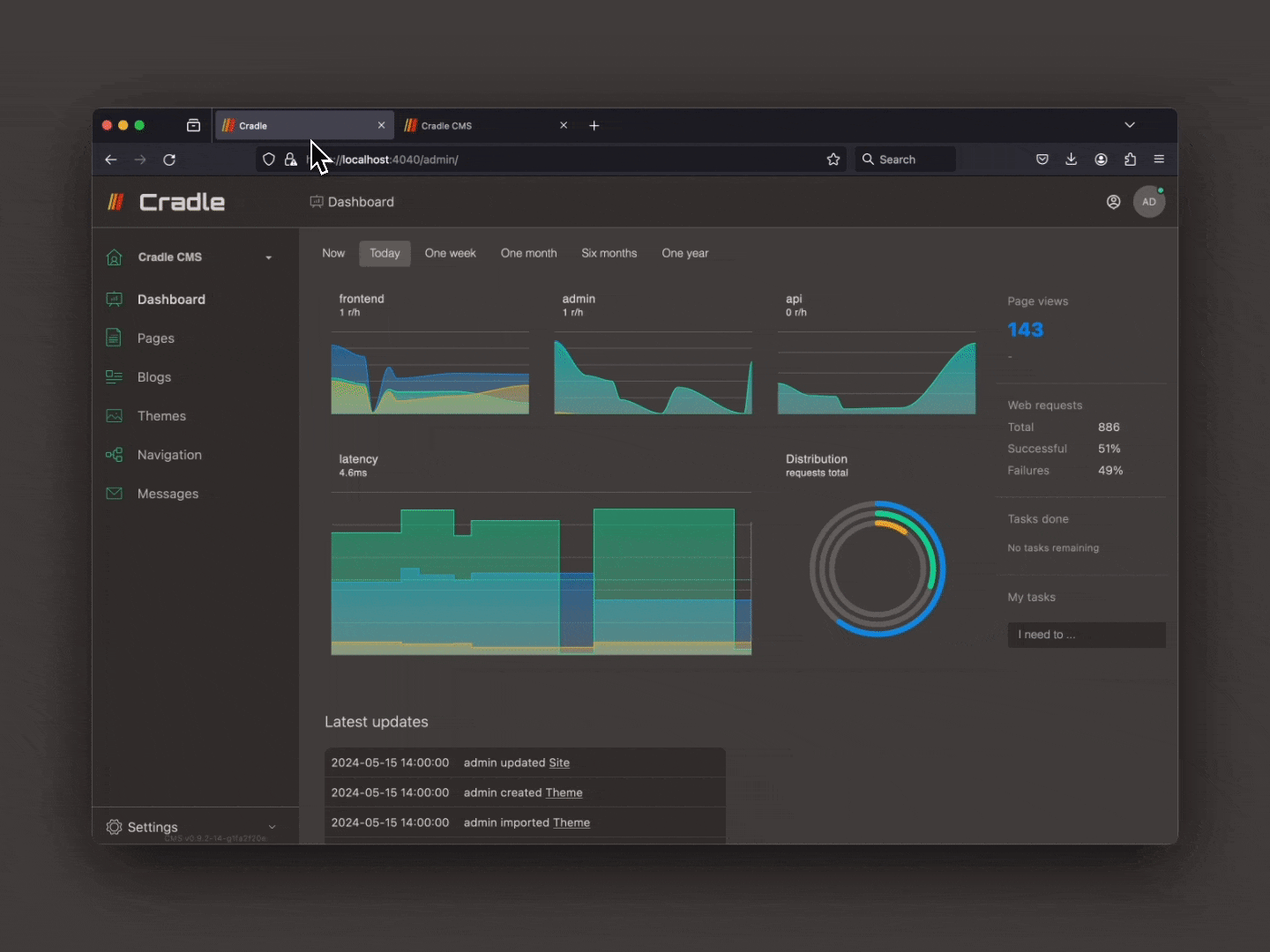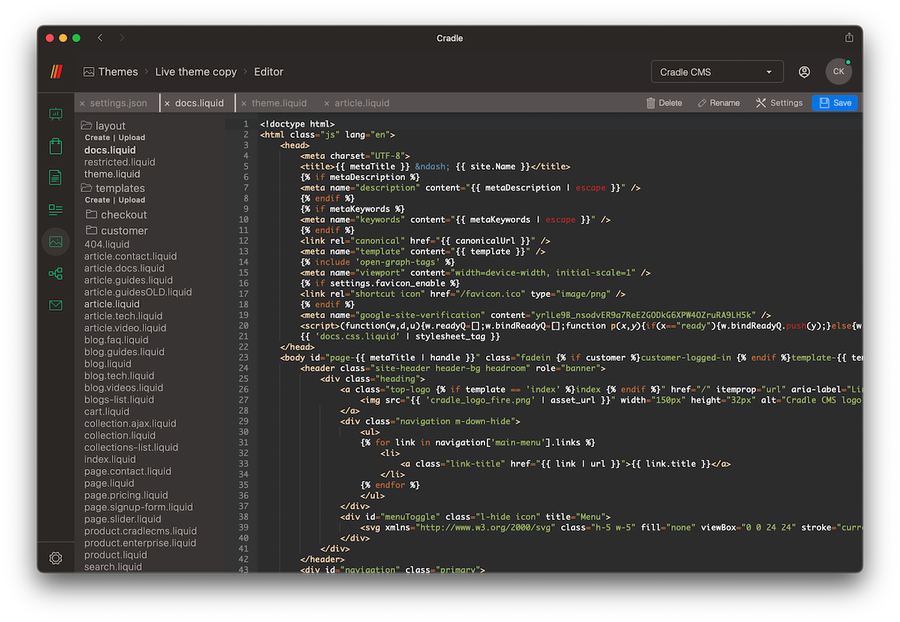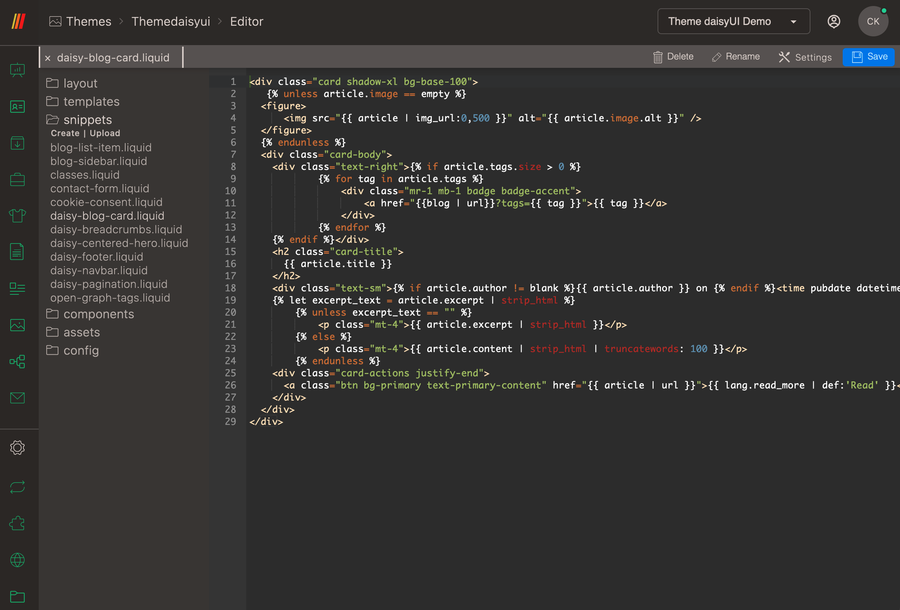
Themes control how the website is built and are written in HTML, CSS, javascript and Liquid as templating language.
It is possible to have multiple themes uploaded at the same time, but only one can be published. Themes can be duplicated, exported, imported and deleted.
There are several premade themes that are customisable with theme settings and theme code. Checkout our github for themes and components.

The easiest way to modify and develop themes is with the built-in code editor. When the site is open it is best to work on a copy of the theme and publish when ready.
Themes can be imported and exported making it possible to work on a theme on a separate site and importing when the theme is ready.
Theme structure
A theme consists of six folders: layout, templates, snippets, components, assets and config. All files ending with .liquid can contain code evaluated server-side.
More about the implementation of Liquid templating with Cradle CMS.
Layouts
The layout folder will contain the main structure files for a website. Commonly two files are present here:
theme.liquid: default file when site is open.restricted.liquid: default file when the site is closed.
Default layout
For open sites theme.liquid is the default layout file for the rendering of all pages for a website.
Example of barebones content for theme.liquid
<!DOCTYPE html>
<html>
<head>
<meta charset="utf-8" />
<title>{{ site.name }}{% if meta.title != blank and meta.title != site.name %} | {{meta.title}}{% endif %}</title>
<meta name="description" content="{{ metaDescription | escape }}" />
<meta name="keywords" content="{{ metaKeywords | escape }}" />
<link rel="canonical" href="{{ canonicalUrl }}" />
{% if template == 'index' %}
<script type="application/ld+json">
{% include 'structured-data' %}
</script>
{% endif %}
{% include 'open-graph-tags' %}
<meta name="viewport" content="width=device-width, initial-scale=1" />
<link rel="stylesheet" type="text/css" href="{{ 'site.css.liquid' | asset_url }}"
<link rel="stylesheet" type="text/css" href="{{ 'editor-styles.css' | asset_url }}"
</head>
<body id="{{ meta.title | handle }}" class="template-{{ template | replace: '.', ' ' | split: ' ' | first | handle }}">
<header>
<h1>{{ site.name }}</h1>
</header>
<main>
{{ contentForLayout }}
</main>
<footer>
<p>Copyright © - {{ site.name }} - All rights reserved</p>
</footer>
</body>
</html>
Using alternative layout
If a template (for example the product.liquid template file) has a specification {% layout 'alternative' %} for an alternative layout, in this case referring to a layout file named alternative.liquid.
Render witout layout
It is possible to render a template without the surrounding template.
{% layout 'none' %}
{{ product | json }}
Templates
The templates folder contains all the template files for the different context in the system and for a web site: index, page, blog, blogs list, article, 404 and search.
| Name | Filename | Description |
|---|---|---|
| 404 | 404.liquid |
Template for 404-page. |
| Article | article.liquid |
Default template for articles. |
| Blog | blog.liquid |
Default template for the blog page. |
| Blogs list | blogs-list.liquid |
Template for page, usually found on /blogs/, that lists all the blogs. |
| Index | index.liquid |
Index page template. |
| Page | page.liquid |
Default page template. |
| Search | search.liquid |
Search page template. |
It is common that a theme contains several templates for the same type of object, for example themes usually contain a page.contact.liquid template that adds a contact form on the pages where the contact template is chosen.
eCommerce
For eCommerce the templates folder includes templates for collections, products as well as for customer accounts and checkout process.
| Name | Filename | Description |
|---|---|---|
| Checkout | checkout/checkout.liquid |
Template for checkout. |
| Confirmation | checkout/confirmation.liquid |
Confirmation page after placed order. |
| Customer account | customer/account.liquid |
Customer account page. |
| Customer addresses | customer/addresses.liquid |
Customer addresses page. |
| Customer invite | customer/invite.liquid |
Customer account invite page. |
| Customer login | customer/login.liquid |
Customer account login page. |
| Order | customer/order.liquid |
Placed order view in customer account. |
| Customer register | customer/register.liquid |
Customer account register page, note that self-registration of accounts needs to be enabled in shop settings. |
| Customer reset password | customer/reset_password.liquid |
Customer reset password template. |
| Cart | cart.liquid |
Cart template |
| Collection | collection.liquid |
Default collection template. |
| Collection list | collections-list.liquid |
Template for page gathering all collections, usually on route /collections/ |
| Product | product.liquid |
Default product template. |
Snippets
Snippets is a folder where code snippets can be stored. Snippets would be used for breaking out parts of the code for reoccurring parts or to make a main layout or template file easier to read.

A typical reoccurring code snippet would be a article card that would be used for a blog section both on the index page and on the blog page. Whereas breaking out code for the header and footer would give an example of what would be broken out for decreasing the complexity of the main layout file theme.liquid.
Components
The components folder holds the code for web components and is similar to snippets but intended to be rendered client side.
Assets
Assets is a place to add CSS- and JS-files.
Media
All images uploaded in theme settings is saved in a media catalogue, this is not displayed in the code editor but will be exported.
Config
Themes comes with theme settings, where options for the theme is built in. These options can handle colors settings, uploading of logos and other website content, as well as, the structure of the site.
In the config folder the theme settings configuration file will determine the options in the settings and the data inserted is stored here as well.
The file settings.json will render the theme settings view which is customisable.
Add themes
Themes can be added by uploading a zip-file or installed from an URL.
Upload theme zip-file
In Themes admin view use the Import theme button located under the Unpublished themes heading to upload a zip-file stored locally in the computer. The uploaded theme will be added to the list of unpublished themes to the right.
Install theme from URL
Any URL pointing to a zip file containing a template, such as an URL from github, can be used for installing a new theme.
In the top right corder of the Themes view 1) press Install theme, 2) add the URL together with specifying a name and a description and 3) press install.
The theme will appear first among the Unpublished themes.
Theme export
All themes can be exported from the Themes page in a zip-file.
The exported zip-file will include all files viewable in the code editor, as well as the media folder, where all the uploaded media is stored.
Theme updates
The themes we provide have continious updates for fixes, enhancements and to reflect feature updates on the software. As Cradle CMS & eCommerce is a self-hosted solution and there is theme code freedom the theme updates are in site owners control.
In a theme update the theme settings and media should be added from the old to the new theme
Steps to update the theme
- Export old theme from the system.
- Download new version of theme from Github.
- In the new version update from old theme
Mediafolder and all the contentsettings_data.jsonfile in theconfigfolder
- Create a zip with the new theme and containing the content from the old theme
- Upload the new theme to the system with
Import theme(an imported theme will be added to the unpublished themes). - View the theme and publish when ready.
If the theme code was changed a
diffis a good way to check to find the changes that should be added.
